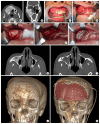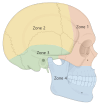Current concepts of craniofacial fibrous dysplasia: pathophysiology and treatment
- PMID: 37150524
- PMCID: PMC10165234
- DOI: 10.7181/acfs.2023.00101
Current concepts of craniofacial fibrous dysplasia: pathophysiology and treatment
Abstract
Fibrous dysplasia is an uncommon genetic disorder in which bone is replaced by immature bone and fibrous tissue, manifesting as slowgrowing lesions. Sporadic post-zygotic activating mutations in GNAS gene result in dysregulated GαS-protein signaling and elevation of cyclic adenosine monophosphate in affected tissues. This condition has a broad clinical spectrum, ranging from insignificant solitary lesions to severe disease. The craniofacial area is the most common site of fibrous dysplasia, and nine out of 10 patients with fibrous dysplasia affecting the craniofacial bones present before the age of 5. Surgery is the mainstay of treatment, but the technique varies according to the location and severity of the lesion and associated symptoms. The timing and indications of surgery should be carefully chosen with multidisciplinary consultations and a patient-specific approach.
Keywords: Bone neoplasms; Fibrous dysplasia; Fibrous dysplasia, monostotic; Fibrous dysplasia, polyostotic; Pathophysiology.
Conflict of interest statement
No potential conflict of interest relevant to this article was reported.
Figures






Similar articles
-
Craniofacial Fibrous Dysplasia: Experience at San José Hospital, Bogotá, Colombia.J Craniofac Surg. 2024 Jun 1;35(4):1177-1180. doi: 10.1097/SCS.0000000000010099. Epub 2024 Apr 3. J Craniofac Surg. 2024. PMID: 38568852
-
Craniofacial fibrous dysplasia: A 10-case series.Eur Ann Otorhinolaryngol Head Neck Dis. 2017 Sep;134(4):229-235. doi: 10.1016/j.anorl.2017.02.004. Epub 2017 Mar 14. Eur Ann Otorhinolaryngol Head Neck Dis. 2017. PMID: 28302454
-
Fibrous dysplasia.Pediatr Endocrinol Rev. 2013 Jun;10 Suppl 2:389-96. Pediatr Endocrinol Rev. 2013. PMID: 23858622 Review.
-
[Craniofacial fibrous dysplasia].Rev Med Interne. 2016 Dec;37(12):834-839. doi: 10.1016/j.revmed.2016.02.008. Epub 2016 Mar 23. Rev Med Interne. 2016. PMID: 27017329 French.
-
Craniofacial fibrous dysplasia: A review of current literature.Bone. 2025 Mar;192:117377. doi: 10.1016/j.bone.2024.117377. Epub 2024 Dec 14. Bone. 2025. PMID: 39681203
Cited by
-
A novel technique for skull base reconstruction in craniofacial fibrous dysplasia surgery using three-dimensional printing and a dental alginate mold: illustrative case.J Neurosurg Case Lessons. 2024 Sep 23;8(13):CASE24262. doi: 10.3171/CASE24262. Print 2024 Sep 23. J Neurosurg Case Lessons. 2024. PMID: 39312803 Free PMC article.
-
Surgical management of an extensive nasal mass in an adolescent: insights from diagnostic imaging and histopathology.J Surg Case Rep. 2025 Jan 7;2025(1):rjae831. doi: 10.1093/jscr/rjae831. eCollection 2025 Jan. J Surg Case Rep. 2025. PMID: 39776829 Free PMC article.
-
Malignant sarcomatous transformation of calvarial fibrous dysplasia: illustrative case.J Neurosurg Case Lessons. 2024 Nov 11;8(20):CASE24537. doi: 10.3171/CASE24537. Print 2024 Nov 11. J Neurosurg Case Lessons. 2024. PMID: 39527784 Free PMC article.
-
Alveolar Bone Box Ostectomy Grafted with Particulate Bone Substitute with Subsequent Dental Implant Placement in a Case of Craniofacial Fibrous Dysplasia Involving the Posterior Maxilla: Case Report and Literature Review.J Clin Med. 2023 Oct 11;12(20):6452. doi: 10.3390/jcm12206452. J Clin Med. 2023. PMID: 37892590 Free PMC article.
-
Fibrous Dysplasia of the Ethmoid Bone Diagnosed in a 10-Year-Old Patient.Medicina (Kaunas). 2024 Dec 31;61(1):45. doi: 10.3390/medicina61010045. Medicina (Kaunas). 2024. PMID: 39859027 Free PMC article.
References
-
- StClair EG, McCutcheon IE. Skull tumors. In: Winn H, editor. Youmans and Winn neurological surgery. Elsevier; 2022. pp. 1444e1–e26.
-
- Yang L, Wu H, Lu J, Teng L. Prevalence of different forms and involved bones of craniofacial fibrous dysplasia. J Craniofac Surg. 2017;28:21–5. - PubMed
-
- Rahman AM, Madge SN, Billing K, Anderson PJ, Leibovitch I, Selva D, et al. Craniofacial fibrous dysplasia: clinical characteristics and long-term outcomes. Eye (Lond) 2009;23:2175–81. - PubMed
-
- Ricalde P, Magliocca KR, Lee JS. Craniofacial fibrous dysplasia. Oral Maxillofac Surg Clin North Am. 2012;24:427–41. - PubMed
-
- Ippolito E, Bray EW, Corsi A, De Maio F, Exner UG, Robey PG, et al. Natural history and treatment of fibrous dysplasia of bone: a multicenter clinicopathologic study promoted by the European Pediatric Orthopaedic Society. J Pediatr Orthop B. 2003;12:155–77. - PubMed
LinkOut - more resources
Full Text Sources

